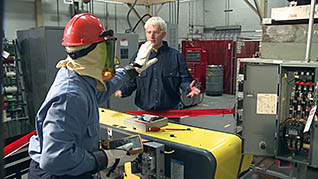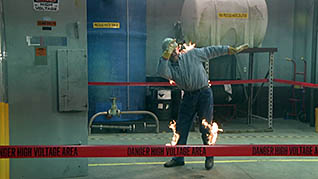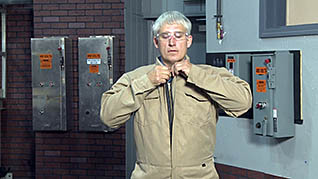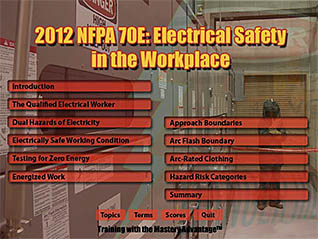Electrical Safety: 2012 NFPA 70E Arc Flash Training
- Product ID
- erises2n
- Training Time ?
- 49 to 98 minutes
- Language(s)
- English
- Video Format
- High Definition
- Required Plugins
- MasteryNet Player
- Lesson Interactions
- 12
- Quiz Questions
- 30
- Closed Captioning



Personal Protective Equipment (PPE) is not always comfortable and may take awhile to get on, but the alternative could easily be injury or death. In order for electrical workers to be safe they must be able to recognize and avoid hazards posed by jobs and equipment. This online arc flash training course provides training participants with an interactive approach to learning and reviewing selected safe practices for electrical workers as defined by the National Fire Protection Association (NFPA) 70E standard.
This program provides in depth coverage of the 2012 NFPA 70E requirements. All workers must be properly qualified for the job being performed. This training demonstrates how to create electrically safe working conditions, use energized electrical work permits, select and wear job specific Personal Protective Equipment (PPE), calculate and understand approach boundaries distances and recognize Arc flash hazards, PPE and boundaries.
The interactivity built into the courses keeps training participants engaged and the quizzes after each lesson ensures the instruction was received as intended. Strict adherence to 2012 NFPA 70E requirements keeps all workers safe. Use this online training to help workers understand the 2012 standard for arc flash safety.
![]() This course is in the Advantage™ format, to read about Advantage™ features click here.
This course is in the Advantage™ format, to read about Advantage™ features click here.

- Install on any SCORM LMS
- Rich multimedia presentation with interactions and quiz
- Print certificate and wallet card
- You have 30 days to complete the course
All electrical workers
-
The Qualified Electrical Worker
- Definition of a Qualified Worker
- Skills of a Qualified Worker
- Other Safe Work Practices
-
Dual Hazards of Electricity
- Two Hazards of Electricity
- Definition of Arc Flash Hazard
- Task Qualified Workers
-
Electrically Safe Work Condition
- Definition of Electrically Safe Working Condition
- Creating an Electrically Safe Working Condition
-
Testing for Zero Energy State
- Known Working Voltmeter
- Safe Work Practices
-
Energized Work
- When Energized Work is Permitted
- Energized Electrical Work Permit
- Exceptions to Permit Requirement
-
Approach Boundaries
- Three Approach Boundaries
- Limited Approach Boundary
- Restricted Approach Boundary
- Rubber Insulating Gloves
- Prohibited Approach Boundary
-
Arc Flash Boundary
- Determining Arc Flash Boundary
- Incident Energy Factors
- Table 130.7(c)
-
Arc Rated Clothing
- Arc Rated Vs. Non-Arc Rated Clothing
- Determining Appropriate Arc Rated Clothing
- Tips for Dressing
-
Hazard Risk Categories
- Common PPE Elements
- Hazard Risk Category 0
- Hazard Risk Category 1
- Hazard Risk Category 2
- Hazard Risk Category 3 & 4
-
Explain the definition and duties of qualified workers.
- Agree that the NFPA uses several strategies facilitate worker safety.
- Recall that electrical workers must be qualified.
- Agree that electrical workers must recognize and avoid hazards.
-
Explain common tasks considered to be arc flash hazards.
- Recall that electric shock and arc flash are two main hazards.
- Explain when an arch flash hazard exists.
- Define the term Task Qualified.
-
Discuss how an electrically safe working condition is created.
- Agree an electrically safe working condition must be the first choice.
- Recall when all sources of electrical supply must be determined.
- Discuss the steps in creating an electrically safe work condition.
-
Explain how to confirm a zero energy state with voltmeter.
- Recall what is required to verify a zero energy state.
- Agree when equipment must be considered energized.
- Recall when arc flash protection may be removed.
-
Discuss the specific conditions in which energized work is permitted
- Agree that energized work is permitted on life support systems.
- Recall the voltage level in which energized work is permitted.
- Identify the exceptions to the electrical work permit requirement.
-
Explain the requirements of each of the three approach boundaries.
- Recall that Limited Approach Boundary is the farthest away.
- Identify when unqualified persons may cross the Limited Approach Bound
- Agree that crossing the Prohibited Approach Boundary is like live work
-
Discuss the methods for determining the Arc Flash Boundary.
- Define what an Arc Flash Boundary is.
- Recall the amount of heat energy required to cause a 2nd-degree burn.
- Identify the elements that affect the incident energy level.
-
Discuss the importance of wearing arc-related clothing when required.
- Define what arc-rated clothing is.
- Agree that cotton or wool clothing can burn after arc flash is out.
- Recall preventing ignition of clothing can be life or death matter.
- Agree that cotton cannot be counted as arc flash protection.
-
Discuss arc flash protection required by the 5 Hazard Risk Categories.
- Recall that ear canal inserts should be work during electrical work.
- Identify the Category where natural fiber clothing is allowed.
- Identify the Category requiring 40 calorie cm2 protection.
- Identify the Category requiring 40 calorie cm2 protection.
- Recall which Category requires a shield, balaclava and suit hood.
© Mastery Technologies, Inc.




